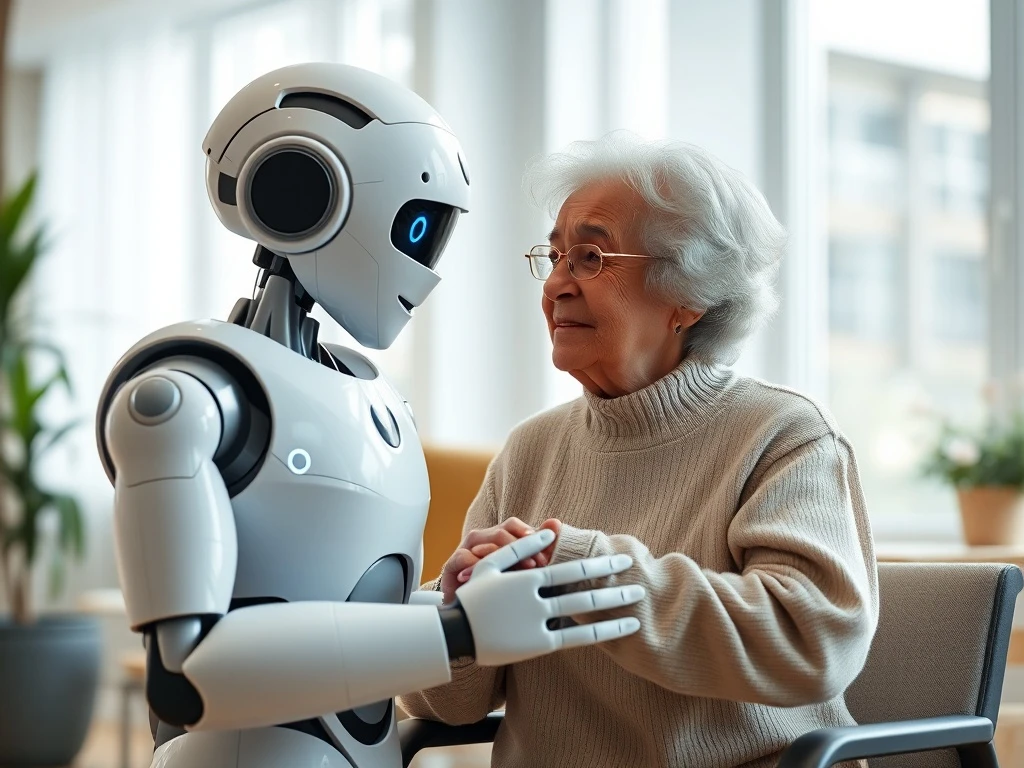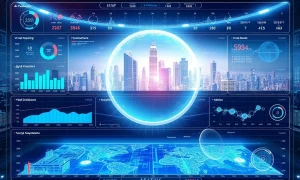The landscape of artificial intelligence and robotics is rapidly evolving, presenting unprecedented opportunities for innovation across various sectors. For entrepreneurs and businesses eyeing the next frontier, the emergence of advanced humanoid robots signals a transformative shift. Fourier Intelligence, a global leader in rehabilitation and assistive robotics, recently announced a significant leap forward with its upcoming GR-3 Humanoid Robot. This development, powered by a strategic collaboration with DeepSeek, promises to redefine human-robot interaction and open new avenues for service delivery.
Introducing the Groundbreaking GR-3 Humanoid Robot
Fourier Intelligence, renowned for its contributions to rehabilitation and assistive technologies, has offered a preview of its highly anticipated GR-3 Humanoid Robot. This cutting-edge machine is slated for official launch in August. Notably, the GR-3 boasts a soft, human-friendly exterior, a deliberate design choice aimed at promoting comfort and ease of interaction. Furthermore, it integrates advanced AI capabilities. This combination positions the GR-3 as a new generation of emotionally intelligent and practical robotics. Many observers consider it a potential challenger to existing high-profile models like Tesla’s Optimus.
The vision behind the GR-3 Humanoid Robot extends beyond mere automation. Instead, it focuses on creating a companion and assistant that can seamlessly integrate into human environments. Fourier Intelligence emphasizes real-world applicability and user safety. Therefore, the robot’s design prioritizes gentle interaction. This approach differentiates it within the rapidly expanding humanoid robotics market.
Strategic AI Collaboration with DeepSeek Enhances the GR-3 Humanoid Robot
A pivotal aspect of the GR-3’s development is Fourier Intelligence’s strategic collaboration with DeepSeek. DeepSeek stands out as a cutting-edge AI research company. This partnership is crucial for the GR-3 Humanoid Robot‘s advanced functionalities. The GR-3 specifically leverages DeepSeek’s proprietary AI learning models. Consequently, it can process complex tasks with remarkable efficiency. It also adapts in real time to dynamic situations. Moreover, it interacts more intuitively with human users.
This powerful alliance allows Fourier to significantly accelerate the cognitive performance of the GR-3. This acceleration is particularly vital in fields such as healthcare, rehabilitation, and eldercare. In these sensitive environments, adaptability, safety, and empathy are paramount. A spokesperson for Fourier Intelligence emphasized the importance of this integration. They stated, “By integrating DeepSeek’s AI framework, we are equipping GR-3 with the cognitive depth needed to function effectively in dynamic, human-centered environments.” This collaboration ensures the GR-3 is not just a machine but a sophisticated, learning entity.
Soft Design and Human-Centric Functionality of the GR-3 Humanoid Robot
Unlike many traditional industrial robots, the GR-3 Humanoid Robot features an intentional soft shell design. This design choice serves a crucial purpose: promoting ease of interaction. It also minimizes any perceived threat or discomfort, especially for vulnerable users. This makes the GR-3 particularly suitable for use in healthcare facilities, nursing homes, and personal assistance settings. Its appearance is less intimidating, fostering trust and acceptance.
The GR-3 offers full-body mobility. It also incorporates a tactile-safe design. Furthermore, it includes intuitive gesture recognition capabilities. These features ensure the robot can move gracefully and interact safely within human spaces. The primary intention behind the GR-3 is not merely to assist, but to coexist comfortably with people in real-world environments. Its soft exterior and advanced sensors work together to prevent accidents and ensure gentle physical contact. This human-centric approach underscores Fourier’s commitment to creating beneficial and integrated robotic solutions.
For example, in a rehabilitation center, the GR-3 Humanoid Robot could assist patients with exercises. Its soft touch would provide reassurance. In an eldercare setting, it might help with daily tasks or provide companionship. Its intuitive gesture recognition allows for natural communication. Therefore, the design reflects a deep understanding of user needs and safety protocols. The GR-3 represents a significant step towards truly integrated human-robot teams.
A Differentiated Approach: GR-3 Humanoid Robot vs. Tesla’s Optimus
Tesla’s Optimus has garnered substantial media attention. Its appearances at events like the World Artificial Intelligence Conference (WAIC) and the China International Supply Chain Expo have sparked considerable interest. However, Fourier Intelligence is taking a distinctly different path with its GR-3 Humanoid Robot. While Optimus has often been showcased behind glass as an experimental prototype, Fourier focuses on practical, publicly accessible deployment.
The GR-3 has been developed with a clear emphasis on real-world application. It prioritizes usability, safety, and direct engagement over experimental showcases. This strategic distinction highlights Fourier’s commitment to bringing functional humanoid robotics to market quickly. They aim to solve tangible problems in specific industries. This contrasts with a broader, more exploratory approach. Fourier’s strategy focuses on delivering immediate value. The GR-3 is therefore built for integration into existing human workflows. It is designed for everyday use, not just for demonstrations.
Consider the core philosophies: Tesla often emphasizes cutting-edge, general-purpose AI and robotics, aiming for broad applicability. Conversely, Fourier has honed its expertise in rehabilitation and assistive robotics. This specialized background informs the GR-3’s design and purpose. The result is a robot engineered for specific, high-value applications. This focus provides a clear market advantage. It allows Fourier to address immediate needs in critical sectors like healthcare.
Market Potential and Applications of the GR-3 Humanoid Robot
The humanoid robotics sector is poised for explosive growth. Projections indicate a market size reaching billions within the next decade. The GR-3 Humanoid Robot is well-positioned to capture a significant share of this expanding market. Its primary target sectors include healthcare, rehabilitation, and eldercare. However, its versatile design and advanced AI capabilities suggest broader applications.
Potential applications for the GR-3 include:
- Rehabilitation Assistance: Aiding patients with physical therapy exercises, providing gentle support, and monitoring progress.
- Eldercare Support: Assisting elderly individuals with daily routines, medication reminders, and companionship. Its soft design ensures safe interaction.
- Personal Assistance: Offering support in home environments for individuals with mobility challenges.
- Education: Serving as an interactive learning tool in specialized educational settings.
- Logistics and Manufacturing (Light Duty): Performing repetitive, delicate tasks where human-like dexterity is beneficial, especially in environments shared with human workers.
The GR-3’s ability to adapt and learn makes it an invaluable asset. It can perform diverse tasks while maintaining a high level of safety. This adaptability ensures its relevance across multiple industries. Furthermore, the rising demand for assistive technologies fuels the market for robots like the GR-3. Businesses seeking to innovate in these areas will find the GR-3 a compelling solution.
The Future Outlook for the GR-3 Humanoid Robot and Robotics Industry
The official launch of the GR-3 Humanoid Robot is anticipated next month. Further details will be released at Fourier’s scheduled announcement event. Industry analysts view this development as a strategic expansion of Fourier’s growing robotics ecosystem. It signals that humanoid robots may soon find viable roles in everyday human environments. This marks a significant shift from conceptual designs to practical, deployable solutions.
The humanoid robotics sector continues to heat up. Many companies are investing heavily in research and development. Fourier’s unique blend of soft design, AI intelligence, and a strong healthcare focus positions the GR-3 as a strong, application-ready contender. This is particularly notable in a field still largely dominated by prototypes and research models. The GR-3 represents a tangible step towards widespread humanoid robot adoption. Its focus on safety and real-world utility will likely accelerate its market penetration.
As AI capabilities advance, so too will the potential of robots like the GR-3. Future iterations could feature even more sophisticated emotional intelligence. They might also boast enhanced dexterity and broader application sets. The ethical considerations surrounding widespread robot integration will also grow in importance. Fourier Intelligence, by focusing on human-centric design, is proactively addressing some of these concerns. The GR-3 Humanoid Robot stands as a testament to this forward-thinking approach. It highlights a future where robots are not just tools, but integral parts of our daily lives, particularly in care and assistance roles.
Frequently Asked Questions (FAQs)
What is the GR-3 Humanoid Robot?
The GR-3 Humanoid Robot is a new soft-designed humanoid robot developed by Fourier Intelligence. It features advanced AI capabilities, thanks to a strategic partnership with DeepSeek. The robot is designed for safe, intuitive interaction in human-centered environments, particularly healthcare and eldercare.
How does the GR-3 Humanoid Robot differ from Tesla’s Optimus?
The GR-3 Humanoid Robot differs from Tesla’s Optimus primarily in its approach. While Optimus has been largely showcased as an experimental prototype, the GR-3 focuses on practical, real-world deployment. Fourier prioritizes usability, safety, and immediate application in specific industries like healthcare, rather than general-purpose exploration.
What are the primary applications of the GR-3 Humanoid Robot?
The GR-3 Humanoid Robot is primarily intended for applications in healthcare, rehabilitation, and eldercare. Its soft design and advanced AI make it ideal for assisting patients with therapy, supporting elderly individuals with daily tasks, and providing companionship in a safe and empathetic manner.
When will the GR-3 Humanoid Robot be officially launched?
The GR-3 Humanoid Robot is set for official launch in August. Fourier Intelligence plans to release further details at a scheduled announcement event.
What role does DeepSeek play in the GR-3 Humanoid Robot’s development?
DeepSeek is a cutting-edge AI research company that has formed a strategic collaboration with Fourier Intelligence. The GR-3 Humanoid Robot leverages DeepSeek’s proprietary AI learning models. These models enable the robot to process complex tasks, adapt in real time, and interact more intuitively with human users, enhancing its cognitive performance.
Why is the GR-3 Humanoid Robot designed with a soft shell?
The GR-3 Humanoid Robot is intentionally designed with a soft shell to promote ease of interaction and minimize perceived threat or discomfort. This design choice is crucial for its intended use in sensitive environments like healthcare facilities and nursing homes, ensuring safe and comfortable coexistence with people.














